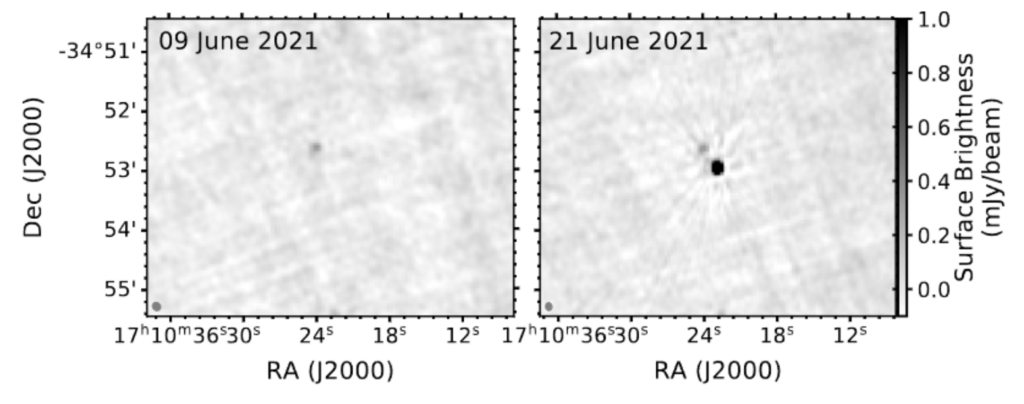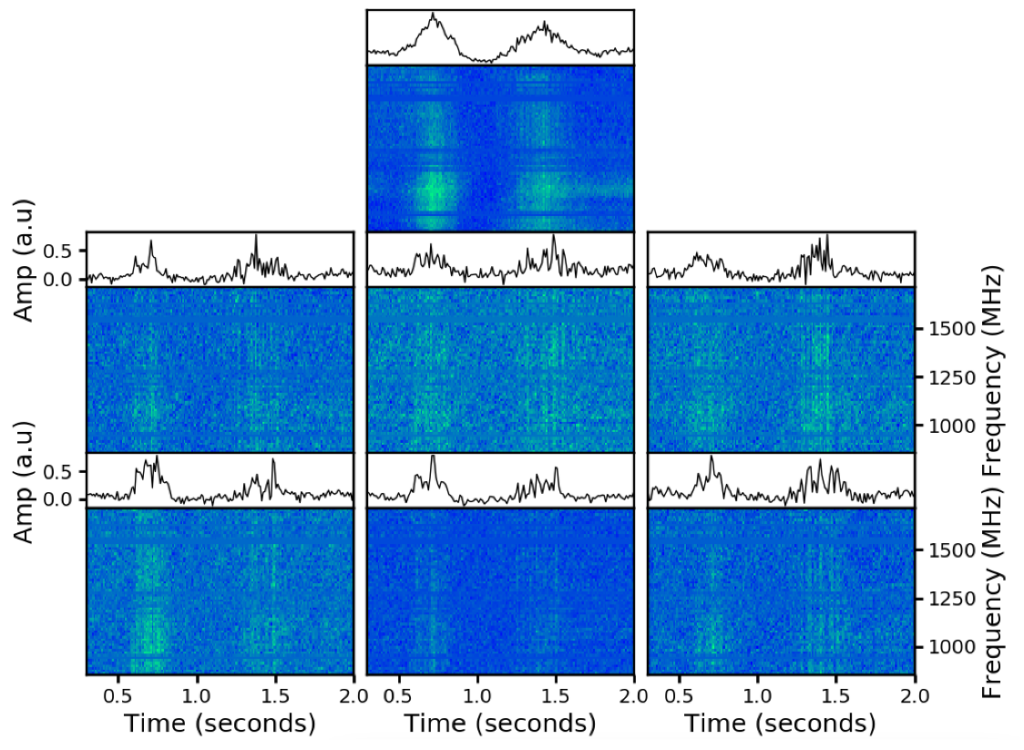Title: Discovery of an Extremely Intermittent Periodic Radio Source
Authors: M. P. Surnis, K. M. Rajwade, B. W. Stappers, et. al (12 additional authors)
First Author’s Institution: Indian Institute of Science Education and Research
Status: Accepted for publication in MNRAS Letters [open access on arXiv]
How can we study an object that only sheds its light on us for a brief moment? Transient astronomy concerns the study of astronomical objects which seem to appear and disappear on short timescales. Today’s paper reports the discovery of an enigmatic source which emitted almost 100 bright radio pulses in the span of 20 minutes, but hasn’t been detected since.
Radio transients are brief, bright pulses of radio waves which can originate from a large variety of sources. We can detect periodic emission from rapidly rotating neutron stars known as pulsars; while they tend to be consistent emitters, some pulsars can turn on and off (nulling) or be extremely intermittent. Magnetars are like the cousins of pulsars: they’re also rotating neutron stars, but tend to rotate more slowly and show emission properties that pulsars don’t. While we believe pulsars are powered by their rotation, magnetars emit outbursts of X-rays which are more energetic than their rotation can account for– instead, we believe that magnetars are powered by the decay of their extremely powerful magnetic fields.
Accidentally Finding a Needle in the Cosmic Haystack
The authors of today’s paper were conducting standard follow-up observations of a pulsar with the MeerKAT telescope when their automatic search pipeline detected bright single pulses which didn’t seem to originate from the target pulsar. These bright pulses did not have the same period (time between pulses) as the target pulsar, leading the authors to believe that this was a different source– but to prove it they’d need to separate the two pulsars’ locations on the sky. As an interferometer made up of several radio dishes, MeerKAT is able to observe a large field of view, letting us make radio ‘images’ or maps of larger patches of the sky which may contain smaller point sources. Single-dish telescopes make a single beam on the sky– you can measure the emission coming from anywhere within that patch of the sky, but you can’t separate out where inside that patch the emission is coming from. On the other hand, interferometers are essentially a giant beam made up of a bunch of smaller beams– so you can make a large map of the sky with very high angular resolution.
MeerKAT takes images by adding up 8 seconds of emission, and the pulses were separated by no less than 10 seconds, so each image either contained one pulse, or none. By stacking up the images taken at the same time as a detected pulse, and subtracting the images which do not contain a pulse, the difference (shown in the right panel of Figure 1) revealed the source of these unexpected bright pulses. This new source is far enough from the known target pulsar that it’s been confidently designated as a new radio source.

So, what is the source of these unexpected bright single pulses? The pulses were all separated by an integer multiple of 10.4 seconds, characteristic of slowly rotating neutron stars– so the object is likely a pulsar, now named PSR J1710-3452 for its sky location (we’ll call it J1710 from here on out for brevity). But pulsars are known for their consistent emission, with pulsars having stable fluxes over the course of years to decades. On the other hand, J1710 showed no detectable emission in 65 other observations of the region taken before or after– the left panel of Figure 1 is a radio image from one of these observations. It also went undetected in many other sensitive radio surveys of the region, and no counterparts at other wavelengths have been observed, so all we have to go on is the single observation from two years ago with detectable emission.
Could J1710 be a Magnetar?
Our standard method for learning about pulsars involves regularly observing them for multiple years, and building a model of the pulsar’s rotation and sky motion over time (a technique called pulsar timing). Using this model we can estimate the physical properties of the pulsar, including its magnetic field and rotational energy. Obviously, this is severely hampered by the fact that we only detected the pulsar in one 20-minute observation, so we can only put weak constraints on our estimates of these values.
Based on the observed change in the rotation period over 20 minutes (or lack thereof), we can only put a very high upper limit on the spin-down rate and thus a very high upper limit on the magnetic field. Even if the true values turn out to be 1,000 times lower than these upper limits, the observed properties of J1710 would still line up better with the magnetar population than with other transient sources of radio pulses.

Zooming in on the individual pulses from J1710 also suggests that it may be a magnetar: the single pulses (shown in Figure 3) are broad, with lots of jittery sub-structure. Magnetars don’t often emit radio waves– only 6 of the 26 known magnetars are radio-loud– but they tend to have broad, highly variable pulses with lots of sub-pulses. The pulses from J1710 have a lot more in common with the average magnetar pulse than an average pulsar pulse, and that (combined with the slow rotation period) lends credence to the idea that it may be a magnetar.
J1710 is uniquely located in our Galaxy, being much higher above the Galactic plane than a typical magnetar– most magnetars are young, and thus close to the plane of the younger Galactic thin disk. J1710 could be an example of an old magnetar, which could explain its position in the galaxy and the fact that we don’t see any associated supernova remnant.
While we usually compare an object to the rest of its population, it’s difficult to get a good handle on how many similar sources to J1710 there could be in our galaxy, given its extremely brief period of detectability. Our radio surveys are also not optimized to detect transient sources like these– we usually scan a sky position for a short period of time and discard very wide pulses, both of which select against objects like J1710 with broad pulses and extremely brief activity periods. An active search for more transient objects could use a different survey strategy, like an imaging survey with long exposures of large fields of the sky. These new techniques might allow us to identify exotic new sources like J1710, laying in wait to be discovered.
Edited by Katherine Lee
Featured image credit: NASA’s Goddard Space Flight Center




